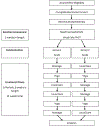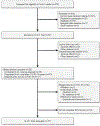A Series of Virtual Interventions for Chronic Lower Back Pain: A Feasibility Pilot Study for a Series of Personalized (N-of-1) Trials
- PMID: 37609556
- PMCID: PMC10443938
- DOI: 10.1162/99608f92.72cd8432
A Series of Virtual Interventions for Chronic Lower Back Pain: A Feasibility Pilot Study for a Series of Personalized (N-of-1) Trials
Abstract
Chronic lower back pain (CLBP) affects 25% of U.S. adults and is associated with high costs due to physician visits and reduced productivity. Research shows that massage and yoga can be effective nonpharmacological treatments for CLBP, but the feasibility, scalability, individual treatment, and adverse-event heterogeneity of these treatments are unknown. The current study evaluated the feasibility and acceptability of a series of personalized (N-of-1) interventions for virtual delivery of massage and yoga or usual-care treatment for CLBP in 57 participants. We hypothesized that this study would provide valuable information about implementing a virtual, personalized platform for randomized controlled trials of personalized (N-of-1) interventions among individuals with CLBP. The study will do so by determining participants' ratings of usability and satisfaction with the virtual, personalized intervention delivery system and, in the long term, identifying ways to integrate these personalized trials into patient care. Of the 57 participants enrolled, two withdrew from the study and were not eligible to receive the primary outcome assessment. Thirty-seven of the remaining 55 participants (67.3%) completed satisfaction surveys comprising the System Usability Scale (SUS) and items assessing satisfaction with the components of the personalized trial. Participants rated the usability of the personalized trial as excellent (average SUS score = 85.8), 95% were satisfied with the personalized trial overall, and 100% stated they would recommend the trial to others. These results suggest that personalized trials of massage and yoga are highly feasible and acceptable to participants with CLBP.
Keywords: N-of-1; massage; pain; personalized; personalized trial; yoga.
Figures






References
-
- Balsa J, Félix I, Cláudio AP, Carmo MB, e Silva IC, Guerreiro A, Guedes M, Henriques A, & Guerreiro MP (2020). Usability of an intelligent virtual assistant for promoting behavior change and self-care in older people with type 2 diabetes. Journal of Medical Systems, 44(7), Article 130. 10.1007/s10916-020-01583-w - DOI - PubMed
-
- Bangor A, Kortum PT, & Miller JT (2008). An empirical evaluation of the system usability scale. International Journal of Human–Computer Interaction, 24(6), 574–594. 10.1080/10447310802205776 - DOI
-
- Brooke J. (1996). SUS: A “quick and dirty” usability scale. In Jordan P. & Thomas B. (Eds.), Usability evaluation in industry (pp. 189–194). Taylor & Francis. 10.1201/9781498710411-35 - DOI
Grants and funding
LinkOut - more resources
Full Text Sources
